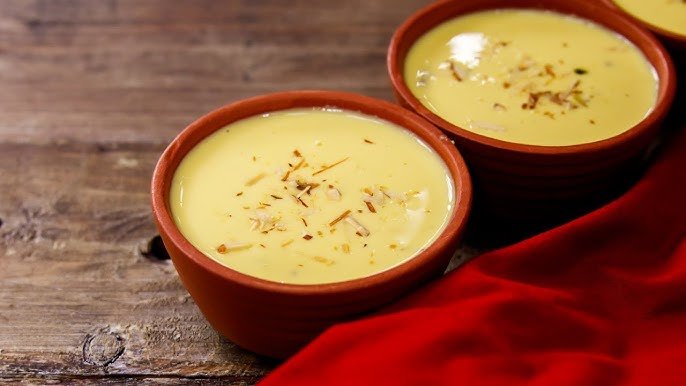No products in the cart.
Delightful Gujarati Sweets: A Taste of Tradition and Flavour
Gujarati Mishthaan is Traditional Flavors and Timeless Delicacies
Instead of impatiently anticipating dessert as the final course, the Gujarati palate has embraced mishthaan as an essential part of the main meal—the thali. Whether it’s the airy delight of Shrikhand or the refreshing summer favorite Aam Ras, Gujarati sweets remain an inseparable indulgence.
Sweets
As fast as the main course is over, foodies worldwide eagerly wait for the last course: dessert. But in Gujarat the dessert is often a part of the main meal, maiking way for itself in the food thali.
The Gujarati doesn’t want to wait for dessert, a word that originates from the French word desservir, meaning ‘to clear the table. And why should anyone have to? Sweets have been a part of the Indian way of life since time immemorial. Our an-cient Sanskrit literature mention feasts and offerings of mithas (sweet). The Manasollasa, which literally translates into ‘delight of the mind and senises’, is an ancient encyclope dia on food, music, and other Indian arts. It includes mentions of many sweet dishes, including the payasam, the Indian version of the rice pudding.
The origin of sweets in the Indian subcontinent dates back to 500 BCE-this is when records suggest that raw sugar, such as gur, vellam, and jaggery, and refined sugar (sarkara) were produced. Not long after sugar-based foods made their way to god’s abode, the temples, where they were used as bhoga and then served as prasad.
Every state in India has its own sweet offerings, and Gujarat is no different. Unlike other states, most Gujarati desserts are not fried; they are made with sugar, jaggery, milk products, and specific flours. The garnishes include almonds, pistachios, cashew nuts, and charoli. Most sweets are flavoured with cardamon, nutmeg, cloves, and saffron
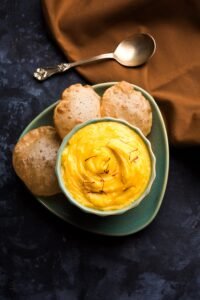
Shrikhand: This light, airy curd-based dessert is one of the oldest desserts to emerg from India and also finds mention in food historian’s KT Achaya’s book. The Historica Dictionary of Indian Food. “To dewater curd, it was hung in a muslin bag for a few hours: sugar and spices added to the mass yielded shikhari-ni (identical to modern day shrikhand), first noted around 500 BC, writes KT Achaya. Flavoured with carda-mom, pistachios, almonds, saffron and nutmeg, shrikhand can be had on its own or lapped up with thin, hot puris.
Keri no Ras: Also known as aam-ras, this summer dessert is relished with hot ghee-laden rotis or puris. The word is derived from the Sanskrit words amra and rasa, the literal translation of this dessert is ‘mango juice’. Gujarat and Maharash-tra may bicker over who ‘owns’ this sweet offering, but their desserts differ signifi-cantly: the Gujarati version is commonly put through a blender to get a smooth, more fluid texture, while the hand-made Maha-rashtrian variant is pulpy and thicker. Often, a dollop of ghee is added to the ras as mango produces heat in the body; Ayurveda says the ghee can quell this. When served at weddings or special occasions, it may include additions like cardamom and chopped fruits.
Amrakhand: This used to be a sea-sonal delight, but the availability of frozen fruit pulp means amrakhand can be enjoyed round the year. The recipe is simple, and involves marrying simple shrikhand with fresh mango pulp (keri no ras). Topped with slivers of almonds and cashew nuts and laced with cardamom and nutmeg, it tastes divine.
Mohanthaal: Said to be Lord Krishna’s favourite sweet, mohanthaal is a firm fa-vourite across Gujarat. Similar to the besan burfi, this traditional dish can be called a ‘besan fudge’ and makes every special event, be it a celebration or a wedding, complete. It brings together gram flour, mava, ghee, and sugar to create melt-in-the-mouth chunks.
Penda/Peda: Traditionally made with milk and mawa. Vadodara’s famous penda/peda can be sourced from Duliram Pendawa la Ratanlal Sharma – the oldest sweet shop in the city. Jay Siyaram Pendawala in Rajkot is also popular for its kesar pendas.

Doodh Pak: This semi-solid, milk-based sweet is the Gujarati version of kheer, one of the oldest desserts that emerged from India. The rice pudding involves simmer-ing milk till it thickens and sweetens a little naturally, after which the rice is cooked completely in the same pot. Garnished with with cardamom and saffron strands, this is a chopped almonds and charoli, and redolent rich dessert that can be eaten on its own or best when chilled.

Sukhdi: This traditional Gujarati sweet wheat flour. Its melt-in-the-mouth texture is prepared using jaggery, ghee and whole will stay with you forever. Thanks to gen-erous amounts of ghee, it’s so soft that its pieces don’t hold well like those of burfi or kaju katli. In winters, edible gum or gaund is also added to the sweet dish.
Gol Papdi: This flaky barfi brings to-gether the goodness of whole wheat flour and jaggery. Most popularly eaten during winters, it’s easily made at home and often also con-sumed as a snack. The ingredients need to be roasted in ghee until they thicken to the right consistency after which the mix is set in slabs on a thali. The taste is so great that garnish-ing with chopped almonds is optional.

Fada ni Lapsi: Broken wheat, or dalia as we know it in India, gets a makeover in this healthy dessert that often works as a one-pot meal. The dalia is roasted in ghee and cooked in milk, and gently flavoured with cardamom, fennel seeds, and saffron. Garnishing with almond slivers and raisins takes the milky dessert to another level.
Sata: This flaky pastry goes by the name Chiroti in Maharashtra. Wheat and refined flour combine with sugar and carda-mom to create an offering so delectable that you’ll wonder why you never enjoyed one be- fore ,The trick lies in frying the Sata on a low flame; they won’t be as crispy and crumbly.
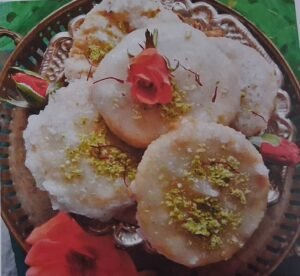
Gahu no Sheero: This healthy sweet made with whole wheat flour can be made in double quick time when you’re looking for a sweet ending to a meal or a carb-laced break-fast. Roasted in ghee, the Gujarati variant of this dessert (it’s also made in other states across India) uses jaggery as a sweetener instead of powdered sugar. Flavoured with cardamom and garnished with mixed nuts and rose water, it’s a huge favourite.
Ghari: Often called the Surti ghari, this sweet originates from the city on the banks of the Tapi. Made with puri dough and replete with a delicious filling of mawa, sugar, and gram flour, the delicacy is deep-fried and dipped in a mix of ghee and sugar. Available in variants like condamsom, pistachio, and almonds, it is traditionally made to celebrate Chandani Padva, the last full moon day in the Hindu calendar.
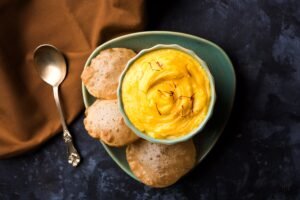
Kaju Badam Puri: This is a gluten-free.flour-free, and butter-free dessert. All it needs is a one-cup nut mixture and half a cup of powdered sugar. Blended with milk, carda-mom, and saffron, the paste is set in thin slabs on thalis and then cut out into delicate roundels
Kansar: A cousin of the Rajasthani churma, kansar is a porridge-like dish made from broken wheat, jaggery, and ghee. Often garnished with chopped and toasted almonds and cashew nuts, this dish traditionally played an important role in Gujarati wed. dings it was cooked by the bride’s mother and served to the groom, indicating the spread of sweetness in his life.

Sev Biranj: It may have been an impor-tant part of Gujarat’s easy-to-make sweets during festivals, but not many know about this sweet vermicelli-based preparation these days. Unlike other desserts, sev biranj uses only a little amount of ghee in its prepara-tion- to roast the vermicelli and give it its characteristic, heady aroma. After that, the vermicelli, or sev, is cooked in milk and flavoured with cardamom and saffron. The crispy-yet-soft texture of the vermicelli complements the creaminess of milk and the punch and aroma of the spices. Sev Biranj can be made fudge style or tender, semi-solid by adding a little milk to it.
Vedmi: The Gujarati version of puran poli has one big difference: the sweet flat-bread is smaller in size and stuffed with tuver dal unlike its Maharashtrian relative that has a filling of chana dal. The delicate flavours of nutmeg and cardamom are common, as is the skill needed to roll out the perfect flat bread. Dabbed with ghee, the roundels are often made during festivals such as Holi and Diwali, and weddings.
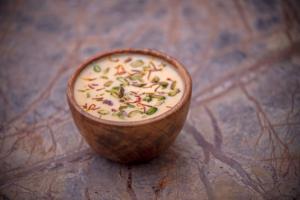
Basundi: This dessert is basically sweet-ened condensed milk made by boiling on low heat typically till the milk reduces in quanity to half. The addition of sugar ensures that the sweet, flavoured with cardamom and saffron, is preserved for long, Basundi is typi-cally garnished with charoli, but other nuts also find favour with sweet lovers.
Halwasan: This delicacy is a specialty of Khambhat, the capital of Cambay State, a princely state of British India. The sticky. fudge-like sweet is made from coarse wheat flour, curdled milk, and edible gum. Spices such as nutmeg and cardamom add delicate nuances to the flavour of the chewy hal-wasan, which is not often prepared at home these days.

Sutarfeni: Sutar means thread while Feni means fine in Gujarati. Making the sutarfeni at home can be a laborious pro-cess as it involves roasting rice flour in ghee (clarified butter) and blending it with melted sugar to form a cotton candy. This is fla-voured with cardamom, and garnished with finely chopped pistachios and almond slivers. The delicacy, believed to have originated in Cambay State, is often scented with rose water or screwpine.
Methi Dana na Ladoo: Soaked fenu-greek seeds meet whole wheat flour in this hardy dessert consumed in winter. Mixed with ed. ible gum, sugar (or jaggery), a hint of milk, nuts, cinnamon, saunth, and cardamom, the laddus stay well in air-tight jars. These sweetmeats are to be found liberally stocked in homes and sweet shops when the chill sets in.

Gulab Pak: Originating from Kutch, gulab pak is essentially a barfi made from rose petals, milk, and sugar. Garnished with chopped and toasted almonds, cashew nuts, and pistachios,
Gundar Pak: What the dink ladoo is to Maharashtra, gundar pak is to Gujarat. The addition of jaggery, nuts like almonds and cashews, cinnamon, saunth, and other warming herbs and spices helps fortify the body’s im-mune system. Traditionally eaten at breakfast with a glass of milk!

Khopra Pak: The Gujarati version of the coconut barfi is made from freshly grated coco-nut, milk, mawa, and sugar. Laid out in slabs and topped with almond and/or pistachio slivers, this dessert is rich in calories.
Magas: People often confuse the magas with the mohanthaal, given that they both are made from coarse gram flour. Redolent of khoya, cardamom and pistachios, magas is a regular feature at potlucks and other gatherings, often served alongside rabri. A traditional Diwali preparation, it can be shaped as barfis or ladoos.
Dudhi no halvo: Gujarati moms are known to fix this homely delicacy in a matter of a few minutes. The goodness of dudhi (bottle gourd) and milk come together, superbly complimented by a generous smattering of cashews, almonds and raisins. The creamy sweetness of the halwa is offset by serving it with namkeen..


